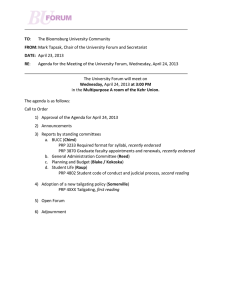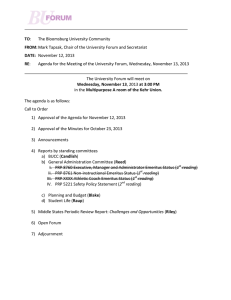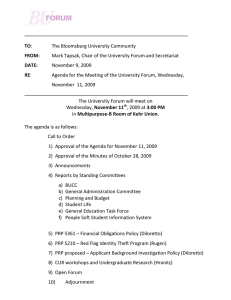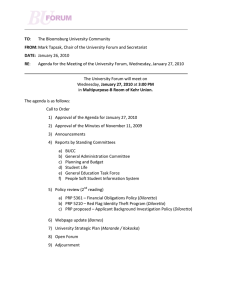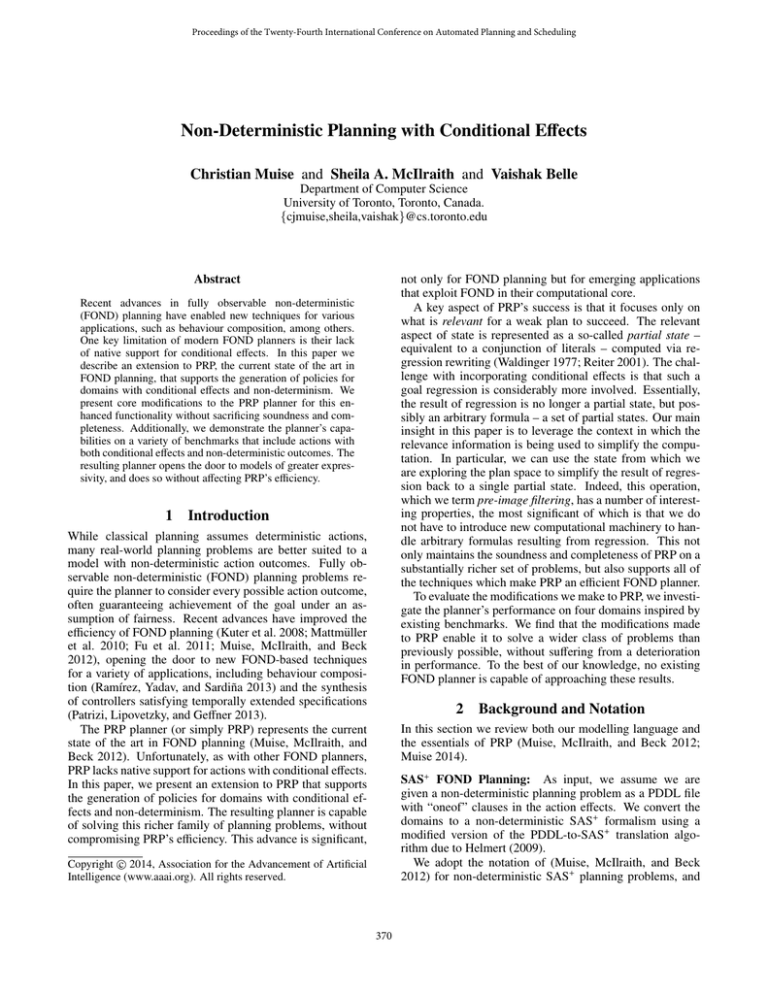
Proceedings of the Twenty-Fourth International Conference on Automated Planning and Scheduling
Non-Deterministic Planning with Conditional Effects
Christian Muise and Sheila A. McIlraith and Vaishak Belle
Department of Computer Science
University of Toronto, Toronto, Canada.
{cjmuise,sheila,vaishak}@cs.toronto.edu
Abstract
not only for FOND planning but for emerging applications
that exploit FOND in their computational core.
A key aspect of PRP’s success is that it focuses only on
what is relevant for a weak plan to succeed. The relevant
aspect of state is represented as a so-called partial state –
equivalent to a conjunction of literals – computed via regression rewriting (Waldinger 1977; Reiter 2001). The challenge with incorporating conditional effects is that such a
goal regression is considerably more involved. Essentially,
the result of regression is no longer a partial state, but possibly an arbitrary formula – a set of partial states. Our main
insight in this paper is to leverage the context in which the
relevance information is being used to simplify the computation. In particular, we can use the state from which we
are exploring the plan space to simplify the result of regression back to a single partial state. Indeed, this operation,
which we term pre-image filtering, has a number of interesting properties, the most significant of which is that we do
not have to introduce new computational machinery to handle arbitrary formulas resulting from regression. This not
only maintains the soundness and completeness of PRP on a
substantially richer set of problems, but also supports all of
the techniques which make PRP an efficient FOND planner.
To evaluate the modifications we make to PRP, we investigate the planner’s performance on four domains inspired by
existing benchmarks. We find that the modifications made
to PRP enable it to solve a wider class of problems than
previously possible, without suffering from a deterioration
in performance. To the best of our knowledge, no existing
FOND planner is capable of approaching these results.
Recent advances in fully observable non-deterministic
(FOND) planning have enabled new techniques for various
applications, such as behaviour composition, among others.
One key limitation of modern FOND planners is their lack
of native support for conditional effects. In this paper we
describe an extension to PRP, the current state of the art in
FOND planning, that supports the generation of policies for
domains with conditional effects and non-determinism. We
present core modifications to the PRP planner for this enhanced functionality without sacrificing soundness and completeness. Additionally, we demonstrate the planner’s capabilities on a variety of benchmarks that include actions with
both conditional effects and non-deterministic outcomes. The
resulting planner opens the door to models of greater expressivity, and does so without affecting PRP’s efficiency.
1
Introduction
While classical planning assumes deterministic actions,
many real-world planning problems are better suited to a
model with non-deterministic action outcomes. Fully observable non-deterministic (FOND) planning problems require the planner to consider every possible action outcome,
often guaranteeing achievement of the goal under an assumption of fairness. Recent advances have improved the
efficiency of FOND planning (Kuter et al. 2008; Mattmüller
et al. 2010; Fu et al. 2011; Muise, McIlraith, and Beck
2012), opening the door to new FOND-based techniques
for a variety of applications, including behaviour composition (Ramı́rez, Yadav, and Sardiña 2013) and the synthesis
of controllers satisfying temporally extended specifications
(Patrizi, Lipovetzky, and Geffner 2013).
The PRP planner (or simply PRP) represents the current
state of the art in FOND planning (Muise, McIlraith, and
Beck 2012). Unfortunately, as with other FOND planners,
PRP lacks native support for actions with conditional effects.
In this paper, we present an extension to PRP that supports
the generation of policies for domains with conditional effects and non-determinism. The resulting planner is capable
of solving this richer family of planning problems, without
compromising PRP’s efficiency. This advance is significant,
2
Background and Notation
In this section we review both our modelling language and
the essentials of PRP (Muise, McIlraith, and Beck 2012;
Muise 2014).
SAS+ FOND Planning: As input, we assume we are
given a non-deterministic planning problem as a PDDL file
with “oneof” clauses in the action effects. We convert the
domains to a non-deterministic SAS+ formalism using a
modified version of the PDDL-to-SAS+ translation algorithm due to Helmert (2009).
We adopt the notation of (Muise, McIlraith, and Beck
2012) for non-deterministic SAS+ planning problems, and
c 2014, Association for the Advancement of Artificial
Copyright Intelligence (www.aaai.org). All rights reserved.
370
extend it to include conditional effects. A SAS+ fully observable non-deterministic (FOND) planning task is a tuple
Π = hV, s0 , s∗ , Ai. V is a finite set of variables v, each having the finite domain Dv . D+v is the extended domain of v that
includes the value ⊥, representing the undefined status of v.
A partial state is a function s that maps variables to values,
i.e. s : V → D+v . If s(v) , ⊥ then v is defined for s, and if every variable v ∈ V is defined for s then s is a complete state.
The initial state s0 is a complete state, and the goal state s∗
is a partial state. A partial state s entails another partial state
s0 , denoted as s |= s0 , iff s(v) = s0 (v) whenever v is defined
for s0 . Two partial states s and s0 are consistent with one
another, denoted s ≈ s0 , iff for all v ∈ V, s(v) = s0 (v) or
s(v) = ⊥ or s0 (v) = ⊥. The updated partial state obtained
from applying partial state s0 to partial state s, denoted as
s ⊕ s0 , is the partial state s00 where s00 (v) = s0 (v) if v is defined for s0 , and s00 (v) = s(v) otherwise. Note that s and s0
need not be consistent for the operator ⊕ to be applied. In
what follows, it will be convenient to speak of the variables
that are defined in a partial state s, which we denote using
vars(s).
Each action a ∈ A is of the form hprea , Eff1 , . . . , Effn i,
where prea is a partial state, and Effi is an effect which is a
set of the form {hcond1 , v1 , d1 i, . . . , hcondk , vk , dk i}, where
condi is a partial state called an effect condition, vi ∈ V, and
di ∈ Dvi . A fully observable deterministic domain, then, is
simply the case where n = 1 for all actions (with arbitrary
k). In FOND domains, action outcomes are outside the control of the agent, and any of Effi can occur. The result of a
particular effect Eff at partial state s is defined as:
executed infinitely often, then every non-deterministic effect
of that action occurs infinitely often. In this work, we are
interested in computing strong cyclic plans.
The approach that PRP uses to compute a strong cyclic
plan is to solve a determinization of the FOND planning
problem repeatedly with various initial states and goals.
A determinization of a SAS+ FOND planning task Π =
hV, s0 , s∗ , Ai is a planning task Π = hV, s0 , s∗ , A0 i where
the actions A are replaced by their corresponding deterministic actions A0 . Here, we exclusively use the all-outcomes
determinization which creates A0 by creating a new action
for every non-deterministic effect of an action in A.
3
PRP with Conditional Effects
The contribution of this paper is an extension of the FOND
planner PRP that allows it to find solutions for problems that
contain actions with conditional effects.
PRP does not produce a universal plan, but rather a strong
cyclic plan that takes the form of a partial policy mapping
a subset of the states to an action. As such there are states
that it handles, returning a next action to perform, and other
states for which it does not. Our core algorithm, following
the basic structure of PRP, is as follows:
1. Initialize Open and Closed lists of states handled by the
incumbent policy P (Open initially contains only s0 );
2. Select and move a state s from Open to Closed such that,
(a) If P(s) = ⊥, run UpdatePolicy(hV, s, s∗ , Ai, P);
(b) If P(s) = a, and a , ⊥, add to Open every state in
{Prog(s, a, Effi ) | a = hprea , Eff1 , . . . , Effk i}\ Closed;
(c) If UpdatePolicy failed in 2(a), process s as a deadend;
Result(s, Eff) = {v = d | hcond, v, di ∈ Eff, s |= cond}
We say an action a is applicable in state s iff s |= prea and a
is possibly applicable in s iff s ≈ prea . When a is (possibly)
applicable in s, and for every hcond, v, di ∈ Eff, for which
either s |= cond or s 0 cond, we define the progression of
s, wrt an action a and effect Eff, denoted Prog(s, a, Eff), as
the updated state s ⊕ Result(s, Eff). When s ≈ cond and
s 6|= cond for some cond, Prog(s, a, Eff) is undefined.
Unlike classical planning, where a solution is a sequence
of actions, a solution to a FOND planning task is a policy
that maps a state to an appropriate action such that the agent
eventually reaches the goal. A closed policy is one that returns an action for every non-goal state reached by following
the policy. We say that a state s is reachable by a policy if
by following the policy, the agent may reach state s.
There are three types of plans for a FOND problem
(Cimatti et al. 2003): weak, strong, and strong cyclic. Intuitively, a weak plan corresponds to an “optimistic plan” that
reaches the goal under at least one selection of action outcomes (i.e., it will have some chance of achieving the goal).
A strong plan corresponds to a “safe plan” and is a closed
policy that achieves the goal in a finite number of steps while
never visiting the same state twice. Often, however, weak
plans are not acceptable and strong plans do not exist. As a
viable alternative, a strong cyclic plan is a closed policy with
the property that every reachable state will eventually reach
the goal using the policy under an assumption of “fairness”.
The notion of fairness used here stipulates that if an action is
3. If Open is empty, return P. Else, repeat from step 2;
The procedure UpdatePolicy is a fundamental computational step of both the original and our extended PRP approach. Primarily, it involves (i) computing a weak plan via
the all-outcomes determinization of hV, s, s∗ , Ai, (ii) computing sufficient conditions for each suffix of the weak plan
to achieve the goal, and (iii) adding the sufficient conditions,
paired with the action at the start of the corresponding suffix, to the incumbent policy P. It is the computation of these
condition-action pairs that is the major challenge in enabling
PRP to handle conditional effects.
PRP has a number of other auxiliary components that are
described in the original work (Muise, McIlraith, and Beck
2012; Muise 2014): (i) deadend detection, generalization,
and avoidance, (ii) stopping conditions for weak plans, and
(iii) conditions for stopping the simulation of action effects
(replacing steps 2(a) - 2(c)). We generalized these components using the intuitions described below.
3.1
Condition-Action Pairs
A critical element in the efficiency of PRP is its ability to
identify the subset of a state that is relevant to the validity of a weak plan that leads to the goal. This subset of
the state, which is simply a partial state, is realized in the
condition of the condition-action pairs that are used to generate the PRP policy. PRP was originally developed for
371
Theorem 1 (Soundness and Completeness). Using Primf
for the conditions computed by UpdatePolicy, our approach
computes a strong cyclic plan iff such a plan exists.
planning problems with no conditional effects. In such a
setting, the conditions of condition-action pairs are equivalent to the states realized by regression (Waldinger 1977;
Reiter 2001) of the goal through the actions in the weak plan.
The regression rewriting operation identifies necessary and
sufficient conditions for the plan suffix to be a valid plan.
Regression in such a syntactically restricted setting leads to
a unique partial state. When conditional effects are introduced, the regression can result in a set of (possibly) different partial states, reflecting the (possibly) different conditions under which execution of the action would lead to the
successor state that is being rewritten. In general, these sets
of partial states could be represented as a disjunction of conjunctions of literals (i.e., DNF). However, PRP requires the
condition of the condition-action pair to be representable by
a unique partial state. This unique partial state can be identified by filtering the regressed formula with respect to the
state in which the action was originally applied when the
weak plan was initially produced. This filtering results in
sufficient conditions for the validity of the plan suffix. To
avoid the computational overhead associated with using full
regression, we instead aggregate the regression and filtering
into a single efficient operation.
More precisely, the definition of regression over conditional effects in SAS+ , Regr(s, a, Eff ), corresponds to that
defined in (Reiter 2001) with the straightforward accommodations for notation. As discussed above, we consider an
operation Primf (Pre-Image Filtering) that combines both
the regression and filtering. Primf utilizes the action effect
and condition that was achieved by the action (as is the case
with standard regression), as well as the state sc that the action was applied in, simply termed the context.
Definition 1. Given partial states s and sc , action a =
hprea , Eff1 , . . . , Effn i that achieved s from sc , and associated
effect Eff = {hcond1 , v1 , d1 i, . . . , hcondk , vk , dk i}, we define
Primf(s, a, Eff, sc ) as the partial state p such that, for v ∈ V:
s (v)
c
p(v) =
⊥
s(v)
where,
Support = prea ∪
That is, as far as correctness is concerned, we reap the same
benefits as the original PRP work, albeit in a considerably
more expressive setting. We now describe how PRP needs to
be modified to accommodate the intuitions described above.
3.2
4
[
Evaluation & Discussion
In this section we report on a preliminary evaluation of the
newly implemented system to give a general sense of the
planner’s capability to solve problems with conditional effects. Because of the lack of planners capable of solving
FOND planning problems with conditional effects, there are
currently no appropriate benchmarks published. To remedy
this, we introduce four domains that are modifications of existing benchmarks from the International Planning Competitions (IPC):1 (1) Search and Rescue (search), (2) Sloppy
Schedule (schedule), (3) Buggy Miconic (miconic), and
(4) Tedious Triangle Tireworld (tireworld). The first three
domains contain conditional effects with a complexity that
makes compiling the actions into new ones without conditional effects too difficult using traditional means, while the
final domain demonstrates how the new planner performs in
domains containing needless conditional effects. We discuss
the details of each domain below.
We conducted the experiment on a 3.4GHz CPU with time
and memory limits of 30min and 1GB. To the best of our
knowledge, Gamer is the only planner previously capable of
solving non-deterministic problems with conditional effects
(Kissmann and Edelkamp 2009). Unfortunately, Gamer is
if v ∈ Support
if v ∈ Added \ Support
otherwise
[
Integration with PRP
The Primf operator provides a means of computing a partial
state that is a sufficient condition for a deterministic action to
achieve another partial state. Wherever PRP originally used
logical regression, we instead use the Primf operator. Unlike
regression, Primf requires a context state to be defined. During the UpdatePolicy procedure, we naturally have a context
state from the forward search procedure, and we use this
state for the computation of Primf, yielding sufficient condition for the goal to be achieved by the plan suffix.
The original implementation of PRP also used regression
when processing deadends (cf. step 2(c) from the above procedure). PRP would regress a deadend state through every
action effect that could lead to the deadend. Unfortunately,
we require a context state to perform the Primf operation. As
such, here whenever a deadend is recorded we also record
the action that led to the deadend along with the previous
state, which provides a context for Primf. While slightly less
general than the original, prohibiting the offending action in
the context allows the planner to avoid reaching the deadend
through similar means. For actions without conditional effects that could lead to the deadend, we resort to the original
PRP method of regression as no context state is required.
cond
i=1...n hcond,v,di∈Effi
Added = {v | hcond, v, di ∈ Eff and sc |= cond}
Intuitively, Support consists of the variables mentioned in
the condition of any conditional effect of a while Added consists of the variables the action made true given the context
sc and a particular action effect, Eff.
Proposition 1. The following properties follow from the
definition of the Primf operator:
1. sc |= Primf(s, a, Eff , sc )
2. Primf(s, a, Eff , sc ) |= Regr(s, a, Eff )
3. When there are no conditional effects
Primf(s, a, Eff , sc ) = Regr(s, a, Eff )
These properties of Primf allow us to generalize PRP to handle conditional effects (c.f. Section 3.2), giving us the following theorem.
1
Planner source and benchmark sets can be found online at http:
//www.haz.ca/research/prp/
372
1200
only capable of handling a simple form of conditional effects, prohibiting it from being used in all but one domain.
Thus, we restrict our analysis to the new PRP system.
In Figure 1 we show both the policy size and the time to
compile the policy for all of the problems in each of the four
domains. Overall, we found that the performance of PRP
was not adversely affected by the additions made to solve
problems with conditional effects. The coverage for each
domain is as follows: search (15/15), schedule (108/150),
miconic (145/145), and tireworld (36/40). In what follows,
we discuss each of the domains and how the planner performed.
Policy Size
1000
800
600
search
tireworld
miconic
schedule
400
200
0
Runtime (s)
103
Search and Rescue: The Search and Rescue domain originates from the IPC-6 Probabilistic track. The planning task
requires the agent to fly to various locations and explore for
a lost human who must be rescued. The action of “exploring” a location non-deterministically reveals whether or not
a human is there and prohibits exploring that location again.
As a result, no strong cyclic solution exists, but the probability of the optimal policy achieving the goal tends to 1 as
the number of locations increases. We converted the probabilistic action effects into non-deterministic action effects in
the same manner described in (Muise, McIlraith, and Beck
2012). This domain poses a challenge for PRP, and we chose
to include it as an example of non-trivial conditional effects.
With the default planner settings, the problems in the
Search and Rescue domain become very difficult to solve –
the planner spends the majority of time trying to prove that
a strong cyclic solution does not exist. The dead-end generalization used by PRP is not applicable for this domain,
and this demonstrates a promising area of improvement for
that mechanism. We limited the search time for the planner on this domain to 10 seconds, and used the best policy
found by that point. No better policy was produced beyond
10 seconds, and PRP would simply timeout trying to prove
no strong cyclic solution existed. The best policy that was
produced by PRP, however, coincided precisely with the optimal policy in the probabilistic setting. In other words, PRP
successfully computed the best policy it could hope to find,
but failed to prove no strong cyclic solution existed within
a reasonable amount of time. It should be emphasized that
even if PRP was permitted to run to completion, there is no
guarantee from the planner that the policy it finds is the best
possible for the domain, as no strong cyclic solution exists.
102
101
100
10−1
10−2
Problem
Figure 1: Policy size and compilation time for all problems
in the four domains (x-axis sorted on problem difficulty).
reduction in coverage is due to the FF heuristic used at the
core of PRP which is not able to solve the determinization
effectively. This may be remedied by modifying PRP to
use a more powerful heuristic, such as LM-cut (Helmert and
Domshlak 2009), for the weak planning process.
Buggy Miconic: We based the Buggy Miconic domain on
the Miconic domain from the IPC-2 competition. In this
domain, an elevator is modelled and a stop action transfers
people on or off an elevator depending on whether or not
they must be picked up or dropped off respectively. Two additional actions allow the elevator to change floors in either
direction. The non-determinism is added to the domain by
changing the up and down actions so that the elevator does
not always arrive at the intended floor. It may stop early
or go beyond the target destination. This non-determinism
models the possibility where human users could choose the
wrong floor or press a button by mistake, and allows the
planner to compensate for this undesired outcome.
The Miconic domain represents one of the largest challenges for the modified version of PRP as far as conditional
effects are concerned – the stop action mentions almost every variable in the precondition which causes PRP to behave
as if it is planning with complete states. Nevertheless, PRP
is still capable of solving every problem in the domain, albeit with a steadily increasing policy size.
Sloppy Schedule: The Sloppy Schedule domain is a modification of the Schedule World domain in the IPC-2 competition. The problem involves processing different physical components in a workshop setting through a series of
actions – painting, sanding, cutting, etc. Non-determinism
was introduced to the domain in two places: (1) to mimic a
“sloppy” operator, in which many of the operations change
the state of the component being processed (e.g., polishing
could cause the paint to wear off), and (2) other machines in
the workshop may become occupied while a component is
being processed. This domain was selected due to the significant number of complicated conditional effects it contains.
The planner finds a very compact policy for the Sloppy
Schedule domain in the problems it was able to solve. The
Tedious Triangle Tireworld: The Tedious Triangle Tireworld domain is a modification of the Triangle Tireworld
domain in the IPC-6 FOND track. In this domain a car must
navigate a map with a possibility of getting a flat tire each
time the car changes locations. For this domain, we replaced
some of the preconditions of the non-deterministic actions
with conditional effects. For example, the car can always try
to drive from one location to another, but it will only succeed
373
References
if it does not already have a flat tire. Ideally, the modified
version of PRP should perform just as well in the Tedious
Triangle Tireworld domain as the original PRP planner on
the Triangle Tireworld domain.
The performance of the modified PRP on the Tedious Triangle Tireworld is almost identical to PRP on the original
domain – the coverage drops from 38 problems to 36 for
the modified domain. This demonstrates that there is very
little impact resulting from modelling action behaviour as
conditional effects in lieu of preconditions. The slight drop
in coverage is to be expected, as the Tedious version has a
much larger branching factor, which slows down the planning process for the determinized planning problems. This
is the one domain in which Gamer is capable of solving instances, but the coverage is only 5 problems out of 40.
5
Cimatti, A.; Pistore, M.; Roveri, M.; and Traverso, P.
2003. Weak, strong, and strong cyclic planning via symbolic model checking. Artificial Intelligence 147(1):35–84.
Fu, J.; Ng, V.; Bastani, F. B.; and Yen, I.-L. 2011. Simple
and fast strong cyclic planning for fully-observable nondeterministic planning problems. In Proceedings of the 22nd
International Joint Conference On Artificial Intelligence,
1949–1954.
Helmert, M., and Domshlak, C. 2009. Landmarks, critical
paths and abstractions: What’s the difference anyway? In
Proceedings of the 19th International Conference on Automated Planning and Scheduling.
Helmert, M. 2009. Concise finite-domain representations
for PDDL planning tasks. Artificial Intelligence 173(56):503–535.
Kissmann, P., and Edelkamp, S. 2009. Solving fullyobservable non-deterministic planning problems via translation into a general game. In Proceedings of the 32nd Annual
German Conference on Advances in Artificial Intelligence,
KI’09, 1–8. Berlin, Heidelberg: Springer-Verlag.
Kuter, U.; Nau, D.; Reisner, E.; and Goldman, R. P. 2008.
Using classical planners to solve nondeterministic planning
problems. In Proceedings of the 18th International Conference on Automated Planning and Scheduling, 190–197.
Mattmüller, R.; Ortlieb, M.; Helmert, M.; and Bercher, P.
2010. Pattern database heuristics for fully observable nondeterministic planning. In Proceedings of the 20th International Conference on Automated Planning and Scheduling,
105–112.
Muise, C.; McIlraith, S. A.; and Beck, J. C. 2012. Improved
Non-Deterministic Planning by Exploiting State Relevance.
In Proceedings of the 22nd International Conference on Automated Planning and Scheduling, The 22nd International
Conference on Automated Planning and Scheduling.
Muise, C. 2014. Exploiting Relevance to Improve Robustness and Flexibility in Plan Generation and Execution.
Ph.D. Dissertation, University of Toronto.
Patrizi, F.; Lipovetzky, N.; and Geffner, H. 2013. Fair LTL
synthesis for non-deterministic systems using strong cyclic
planners. In Proceedings of the 23rd International Joint
Conference on Artificial Intelligence, 2343–2349.
Ramı́rez, M.; Yadav, N.; and Sardiña, S. 2013. Behavior
composition as fully observable non-deterministic planning.
In Proceedings of the 23rd International Conference on Automated Planning and Scheduling, 180–188.
Reiter, R. 2001. Knowledge in action: logical foundations
for specifying and implementing dynamical systems. The
MIT Press.
Waldinger, R. 1977. Achieving several goals simultaneously. In Machine Intelligence 8. Edinburgh, Scotland: Ellis
Horwood. 94–136.
Concluding Remarks
We presented an extension to the PRP planner that enables
it to solve FOND planning problems in domains where actions may contain conditional effects. Our modifications to
PRP were systematic: a number of formal and computational steps were necessary to benefit from all of the features that make PRP a competitive solver. Most significantly, we maintained the soundness and completeness of
the planner. Additionally, we conducted a preliminary investigation into the strengths and weaknesses of the newly
created planner and found that it is highly capable of solving non-deterministic problems with conditional effects. As
is to be expected, certain domains can make the planning
process more difficult in this more expressive setting: we
discovered a domain where the deadend generalization is
insufficient for the problems to be optimally solved, and another that requires a more powerful heuristic for the determinization component. We think these are worthy of further
study, and computational schemes that may work here are
left for the immediate future. We also hope to investigate
a refinement of Primf that more closely captures the result
of regression. Alternatively, we may return to the computation of policy conditions via regression, accompanied by
further modifications to PRP. The newly introduced planner
represents an important increase in the scope of problems
that can be solved by non-deterministic planning techniques.
This development is significant not only for FOND planning
but for emerging applications that can exploit FOND planning in their computational core (e.g., (Ramı́rez, Yadav, and
Sardiña 2013; Patrizi, Lipovetzky, and Geffner 2013)).
Acknowledgements We gratefully acknowledge funding
from the Natural Sciences and Engineering Research Council of Canada.
374

